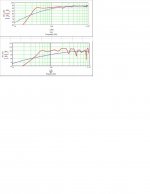Consider both pictures of simulations by M.J. King of a Mass Loaded Tapered Quarterwave Tube (ML-TQWT, top) and a Back-Loaded Horn (BLH, bottom). Both are for a Fostex FE 208 Sigma. Considering both simulations, why would anyone build a BLH, as its SPL response it not nearly so good as the ML-TQWT.😕
Attachments
The obvious of course is effeciency. However I really think you need to hear a well designed one, they certainly don't sound ragged as their FR graph would suggest. If you have the space and woodworking tools I would certainly go for the backloaded horn. They seem to have a much larger "presence" than the same driver in an ML-TL, and of course are more dynamic. I really think the simulations/measurements can be misleading.
Here is a review of a Lowther first in a MLTL and then in a backloaded horn.
http://www.tnt-audio.com/casse/lowtherpm2a_e.html
I'm not trying to trash on MLTL's, I'm just saying don't dismiss backloaded horns, because the don't look good on paper. What they sound like is the key.
Joe
Here is a review of a Lowther first in a MLTL and then in a backloaded horn.
http://www.tnt-audio.com/casse/lowtherpm2a_e.html
I'm not trying to trash on MLTL's, I'm just saying don't dismiss backloaded horns, because the don't look good on paper. What they sound like is the key.
Joe
I completely agree, I have built both MLTL and BLH for the 206E. Although the horns have less bass extension, it is better defined. The horns give a much more real presentation than the MLTL.
Dynamics are much more important than I had thought in the past. With the horns in my system I spend a lot more time listening to music, not the speakers.
I do have to give TL enclosures some credit though, I've had excellent results with them when using small drivers (103E, 126E, TB 657) they simply outweighed horns with their 'massive' bass, the small drivers kept enough of their dynamic nature to make horn construction unnecessary, IMO anyway.
Dynamics are much more important than I had thought in the past. With the horns in my system I spend a lot more time listening to music, not the speakers.
I do have to give TL enclosures some credit though, I've had excellent results with them when using small drivers (103E, 126E, TB 657) they simply outweighed horns with their 'massive' bass, the small drivers kept enough of their dynamic nature to make horn construction unnecessary, IMO anyway.
Agree with the above posts. Dynamics are simply far better in BLH. And they are unmeasurable or apparently unimportant to the CW, yet easily heard. If you want to choke a driver, do it in a multiway and go back to padded and crossed over drivers and multways.
Sealed does fine (gain simplicity of structure), acknowledging inherent shortcomings and maybe some transient response improvements. But like dynamics, bandwidth in a single driver extends cohesion out of the as-acutely-perceptable areas. The sole goal of these drivers intent is to push bandwidth and dynamics way beyond boxes and attempt to gain on compression drivers for realism (read:beautiful imageing). And in the midrange they certainly do. In the bass, that is an art form Fostex challenges you to come up with. And no sim on the planet will tell you what a BLH is *supposed* to sound like.
If you want ML-tqwt there are better drivers than the ones designed specifically for BLH. The Fostex alnico fullrangers would do better for extension and smoothness, but you loose efficiency (but don't also have to use BSC if done right due to higher driver Q, you'd loose the fficiency but also gain a haze). Tradeoffs, but a logical engineering plan was inherent to these drivers design.
TC
Sealed does fine (gain simplicity of structure), acknowledging inherent shortcomings and maybe some transient response improvements. But like dynamics, bandwidth in a single driver extends cohesion out of the as-acutely-perceptable areas. The sole goal of these drivers intent is to push bandwidth and dynamics way beyond boxes and attempt to gain on compression drivers for realism (read:beautiful imageing). And in the midrange they certainly do. In the bass, that is an art form Fostex challenges you to come up with. And no sim on the planet will tell you what a BLH is *supposed* to sound like.
If you want ML-tqwt there are better drivers than the ones designed specifically for BLH. The Fostex alnico fullrangers would do better for extension and smoothness, but you loose efficiency (but don't also have to use BSC if done right due to higher driver Q, you'd loose the fficiency but also gain a haze). Tradeoffs, but a logical engineering plan was inherent to these drivers design.
TC
- Status
- Not open for further replies.
